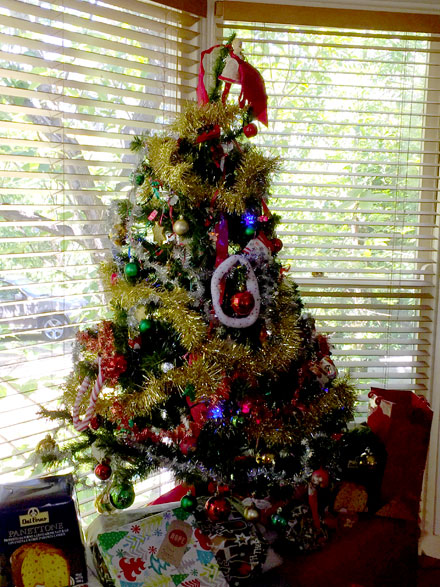
A Christmas tree adorned with ornaments and lights is a centrepiece of the festive season. But have you ever wondered where the tradition comes from? Source: ABC News
Evergreen trees and plants have been used to celebrate winter festivals for thousands of years, long before the advent of Christianity.
Pagans in Europe used branches of evergreen fir trees to decorate their homes and brighten their spirits during the winter solstice.
Early Romans used evergreens to decorate their temples at the festival of Saturnalia, while ancient Egyptians used green palm rushes as part of their worship of the god Ra.
“The idea of bringing the evergreen into the house represents fertility and new life in the darkness of winter, which was much more of the pagan themes,” Dr Dominique Wilson from the University of Sydney said.
“That’s also where the ideas of the holly and the ivy and the mistletoe come from because they’re the few flowering plants at winter so therefore they hold special significance.
“So the idea of bringing evergreens into the house started there and eventually that evolved into the Christmas tree.”
There are several theories and legends as to how the evergreen fir tree went on to become a symbol of Christianity.
One is credited to the English Benedictine monk Boniface, famous for his missionary work in Germany during the eighth century.
“The common story goes that [Boniface] encountered some native Germans performing some sacrifices in front of a mighty oak tree — oak trees being sacred to the god Thor,” Dr Wilson said.
“Boniface seized his axe and felled the tree in order to stop the pagans worshiping a false idol and the pagans were waiting for him to be struck down by lightning, but it didn’t happen.
“So at this stage he took the opportunity to convert them.”
Then legend has it that a fir tree grew out of the fallen oak.
“That became a symbol of Christ — being triangular in shape it represents the trinity — and from there came the idea that the tree should be a symbol of Christ and new life,” Dr Wilson said.
“That’s one of the main origins of the Christmas tree and bringing it into the house.”
Modern Christmas trees emerged in western Germany during the 16th century as Christians brought trees into their homes and decorated them with gingerbread, nuts and apples.
“It’s the 17th century that we really get the decorating happening, and we get a movement into the festivals and the big royal courts having these trees with the gold leaf on them, having paper decorations with candles,” Dr Wilson said.
The custom became popular among nobility and spread to royal courts across Europe in the early 19th century.
As Germans emigrated to other parts of the world the tradition also spread. But in places like the United States, having a Christmas tree was often viewed as a foreign pagan custom until the mid-19th century.
While the Christmas tree originated in Germany, it was Britain’s Queen Victoria and Prince Albert who popularised it in the 1840s and 1850s.
Victoria’s mother, Princess Victoria of Saxe-Coburg-Saalfeld, was German so she grew up having a decorated tree at Christmas time.
But the idea of decorating a whole tree was not common among Brits until a drawing of the royal family celebrating around a decorated Christmas tree in Windsor Castle was published by the Illustrated London News in 1848.
Victoria and Albert were popular royals and soon every British home had a tree decked out with decorations, candles and sweets.
The same image was published two years later in the United States in Godey’s Lady’s Book — though Victoria’s tiara and Albert’s moustache were removed to make the image more American.
It was the first widely circulated picture of a decorated evergreen Christmas tree in the US and soon the Christmas tree was in vogue.
Today, Christmas trees come in all different shapes and sizes from traditional fir to artificial.
The tradition of decorating a tree is embraced by millions of people worldwide of different faiths and cultures.
While it is still a symbol of Christianity to some, to others it is simply part of December celebrations.
“Here in Australia we’ve embraced the European aspect of Christmas,” Dr Wilson said. “We eat the fish and the prawns, et cetera, but I think we are relatively traditional.
“The fact that so many of us still do the turkey and the ham, placing the gifts under the tree — that’s definitely something that links back to our European roots.”







